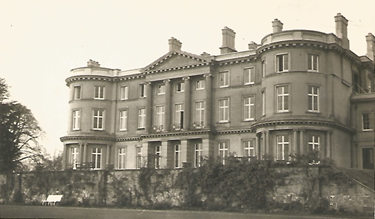The Tombstone of Tadia Vallaunius
This tombstone is part of the collections of Amgueddfa Cymru – National Museum Wales.
Photograph taken 7/7/2015
This
tombstone is on display in the National Roman Legion Museum and it is a
favourite of mine because it relates to a woman who had reached the age of 65
and it was put up by her ‘devoted daughter’ Tadia Exuperata. I love the use of
the term ‘devoted’. It shows a strong family link that was based on Isca
Legionary Fortress and the ‘canabae’ or civil settlement that surrounded it. The
photo is one of mine and I have brightened the original a bit so that it is easier
to read the inscription.
The tombstone (RIB 369): This is the tombstone of Tadia
Vallaunius and also commemorates her son Tadius Exuperatus who died in a war
‘on the German Expedition'. He seems to have been the son of a legionary
soldier from Caerleon and a local lady, Tadia Vallaunius. Vallaunius is a Celtic name and although this 'us' ending is masculine in Latin, it can also be found in Celtic feminine names. Tadia has a female Latin ending and Tadius a male Latin ending.The son
seems to have followed his father into the army and was posted to Germany,
where unfortunately he died. The precise nature of the German expedition is
unknown, but if future research were to shed light on this it would help to
date the tombstone more accurately.
In Richard Brewer’s book ‘Caerleon and the Roman army: Roman Legionary Museum: a guide’ we learn that sometimes goods were placed in the graves and there was often a coin which was ‘the ferryman’s fee’ for ferrying the dead across the river to the world of the dead.
The D and M on the tombstone stand for D(is) M(anibus) which suggests a second century date. It means to the spirits of the departed and the stone would have been upright not flat on the ground. The style of the lettering is similar to other inscriptions from Caerleon (cf RIB 371 and RIB 365) and was probably the work of the military workshop.
The
inscription
D(is) M(anibus)
Tadia Vallaun[i]us vixit
ann(os) LXV et Tadius Exuper(a)tus
filius vixit ann(os) XXXVII defun(c)-
tus expeditione Germanica
Tadia Exuperata filia
ma[t]ri et fratri piiss(i)ma
secus tumulum
patris posuit
Tadia Vallaun[i]us vixit
ann(os) LXV et Tadius Exuper(a)tus
filius vixit ann(os) XXXVII defun(c)-
tus expeditione Germanica
Tadia Exuperata filia
ma[t]ri et fratri piiss(i)ma
secus tumulum
patris posuit
The translation: To the spirits of the departed;
Tadia Vallaunius lived 65 years and Tadius Exuper(a)tus, her son, lived 37
years, having died on the German expedition; Tadia Exuperata, the devoted
daughter, set this up to her mother and brother beside her father’s tomb.
The Discovery: The tombstone was discovered in 1849
at Pil Bach Farm on the road leading out of Caerleon towards Bulmore. It is
mentioned in John Edward Lee’s article ‘Descriptions of a Roman Building and
Other Remains Lately Discovered at Caerleon.’
See Archaeologia Cambrensis. No. XIV April 1849. He founded Monmouthshire
Antiquarian Association in 1847 which was then known as Caerleon Antiquarian
Association.
Follow the
link below for Lee’s article
The
tombstone was eventually displayed in the newly constructed museum built by
Caerleon Antiquarian Association in 1850. It is wonderful to think that after
all these years it is still on the same site but in a newly constructed museum. It is now under the care of National Museum
Wales.
The date:
It is thought to be second century AD. Soldiers
received burials in Roman times as there were compulsory deductions from their
pay into a burial club.
Since the soldiers had money deducted from their pay for their own memorial,
they often wanted the same provision to be available to members of their family
and that seems to be the case here. Up to the Second Century most were
cremated and the remains placed in a pot or glass bottle but after this date inhumation became the dominant rite. Stone or wooden coffins were usual.
Age mentioned on other tombstones in the National Roman Legion Museum
Although Tadia’s age is given as 65 this might well be rounded up or an approximation. There are far more ages recorded in round numbers or in fives than in precise numbers (although some ages were recorded in years, months and days!). In the Museum you will also find the tombstone of Julia Secundina, set up by her son, Gaius Julius Martinus, who lived to be 75 (RIB 373). Her husband, the veteran Julius Valens is recorded on his separate tombstone as being 100 years old when he died (RIB 363).
NOTE: RIB
plus a number relates to the ‘Roman Inscriptions of Britain’ database. To while
away hours of time have a look online and type in Caerleon.
Information provided by Christabel
Hutchings and Marilynne Raybould



